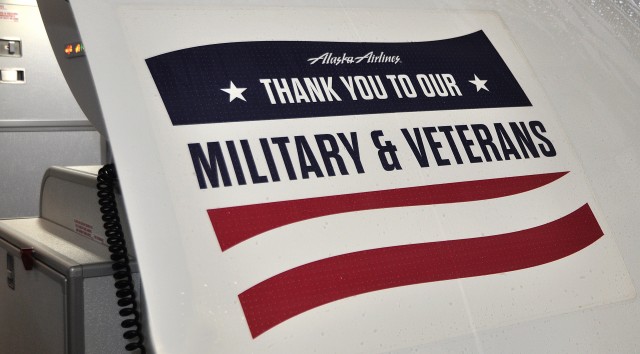
Special sign on the outside of Alaska Airline’s first Boeing 737-900ER. Image from Alaska.
For my “real” job I am a Career Counselor at a local state university. One of the things I enjoy most about my job is helping veterans transition from the military and college life to the working world. In December I will be presenting at a conference on hiring veterans and highlighting companies that are doing some pretty cool things with veterans. One of those companies is Alaska Airlines (I love when my world’s collide). To celebrate Veteran’s Day this year, Alaska has shared a story, that I wanted to repeat on the blog. To all of those who have served, are serving or are planning to serve — I thank you and hope to be able to assist you in your future career aspirations. Here is Alaska’s story:
In the days leading up to Veteran’s Day, Horizon Air Captain Lawrence Pavlinovic has a number of people to thank, gratitude to express and wisdom to pass along to his two sons. Born to immigrant parents, Pavlinovic not only understands the concept of freedom, he fights for it, and works for a company that generously supports his efforts.
Pavlinovic has worked as a pilot for Horizon Air since 1998, and since that time has experienced several military deployments lasting from one to two years. Each time he’s returned to Horizon, his job was waiting for him.
“It’s hard to describe how that feels, to know that your job will be there when you return from active duty,” says Pavlinovic, who is a Lt. Colonel in the Army Reserves, working in logistics and specializing as a linguist. “I can serve my country without worrying whether I will have to look for a job when I return home. When you serve in a hostile region, you need to be very focused on your work, and not whether your employer back home may hire somebody else for your job.”
BONUS: More on Alaska Airlines, veterans and fallen soldiers
Greg Smith, Alaska Airlines project manager with the Project Management Office, recently returned from three weeks of military training. He is grateful that his colleagues filled in while he was away, and thankful to a company that supports his efforts by keeping his job open for him. During his last deployment to Afghanistan, Smith, who worked for Verizon Communications at the time, returned stateside to discover his job was gone when the telecommunications giant sold off certain segments of the company. “My job was basically eliminated,” says Smith, an Army Reserves major working in Afghanistan as a logistician. “It’s very stressful when that happens, and it happens more often than you know.”
Under the Uniform Services Employment and Reemployment Rights Act, reservists and National Guard members who are called to leave their jobs to perform active duty are given rights to re-employment in their civilian jobs, according to Laura Harlos, Alaska Air Group’s manager of compliance and diversity programs. Additionally, employees returning from active duty are entitled to all rights, benefits and seniority they would have received had they never left.
Surprisingly, despite the law, some employers are less enthusiastic about employees leaving to serve their country, according to the Employer Support of the Guard and Reserve (ESGR). Some employers look for ways to circumvent the law, or find loopholes. Companies can downsize, lay off employees or sell the business to another company and returning soldiers often fall through the cracks.
Not at Alaska Air Group. The company has won several awards from the ESGR in the past few years for supporting employees deployed to war or to training.
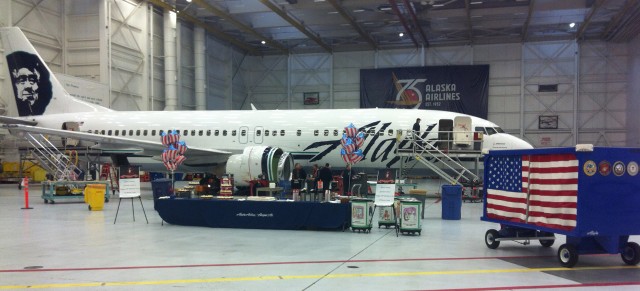
iPhone photo I was able to take of an Alaska Airlines Boeing 737 and the fallen soldier baggage cart at the airline’s maintenance facility in Seattle during a special Veteran’s event in November 2011.
“We value their service we don’t consider it a burden, we consider it a valuable asset,” says Scott Lautman, Alaska Air Group’s human resources manager for maintenance, engineering and safety. “Along with the Alaska Spirit, enthusiastic support of our reservists has become part of our DNA.”
For Pavlinovic, the Air Group’s support of his military service comes to mind when he talks to his sons, age 14 and 17, about how fortunate they are to be Americans. A proud Croatian American, Pavlinovic’s parents came from Croatia and Pavlinovic, who was born in Seattle, spent many years living with his grandparents in the “old country.”
“I want my boys to understand how fortunate they are to have opportunities, to have the support of a country and to have freedom,” says Pavlinovic. “Many in the world don’t have that freedom and some who have it take it for granted. Not at my house.”
Pavlinovic joined the military to pay back his country for giving his parents a home and giving his father the opportunity to work to support his family. His father worked for Pan Am at the ticket counter at Seattle-Tacoma International Airport for many years, and Pavlinovic always wanted to be a pilot. Wearing corrective lenses, the Seattle native could not be a pilot in the military, so he became a linguist instead. He saved his money and paid for flying lessons so he could become a commercial pilot.
In January of 2010, Pavlinovic was deployed to England to work for the Joint Analysis Center for European Command. He worked closely with LaMar Haugaard, chief pilot for Horizon Air, to schedule the time off, and upon return, to enroll in ground school for any updates he might have missed. Pavlinovic returned to Horizon in October of 2011.
“I can’t thank the company enough for their support,” Pavlinovic says. “I really missed flying and when I contacted Horizon to tell them my deployment was finished, they said to come on home.”
Both Pavlinovic and Smith say there are certain observances throughout the year when a thank you doesn’t seem adequate.
“Fourth of July, Memorial Day and Veteran’s Day those are the times when you reflect on what you are doing, and those around you that support what you are doing,” says Smith. “It’s a time when I stand a little taller, and allow myself to feel pride熔f my service, of my employer and of my country.”
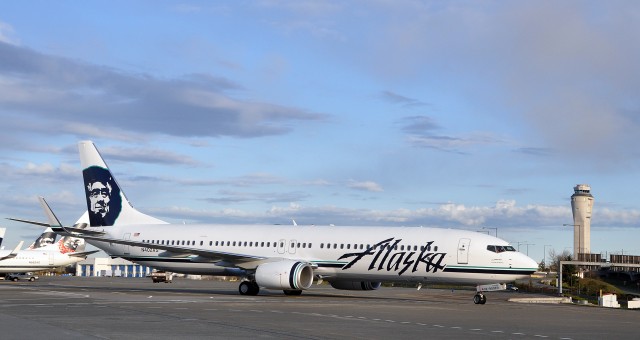
Alaska Airlines first Boeing 737-900ER (N402AS) is seen at Seattle-Tacoma International Airport. Image from Alaska Airlines.
Yesterday, Alaska Airlines introduced their first Boeing 737-900ER. This aircraft is the newest that is in production for the 737 family and adds a number of firsts for the airline.
Each 900ER delivered (Alaska has ordered 38) will feature the Boeing Sky Interior, new Recaro seats and 181 total capacity (16 in First, 165 in economy), which is nine additional passengers than the 737-900. The -900ER was not stretched over the -900;the additional room comes from re-designing the rear bulkhead to be flat rather than curved.
“Boeing’s Sky Interior and our new custom-designed seats represent the most significant cabin upgrades for Alaska Airlines in more than 20 years and are part of our goal to make flying more comfortable for our customers,” said Brad Tilden, Alaska Airlines’ president and CEO. “In addition to an improved cabin experience, the 737-900ER has environmental benefits, as well. On a flight between Seattle and Newark, New Jersey, for example, the 737-900ER burns 3 percent fewer gallons per seat than a 737-900.”
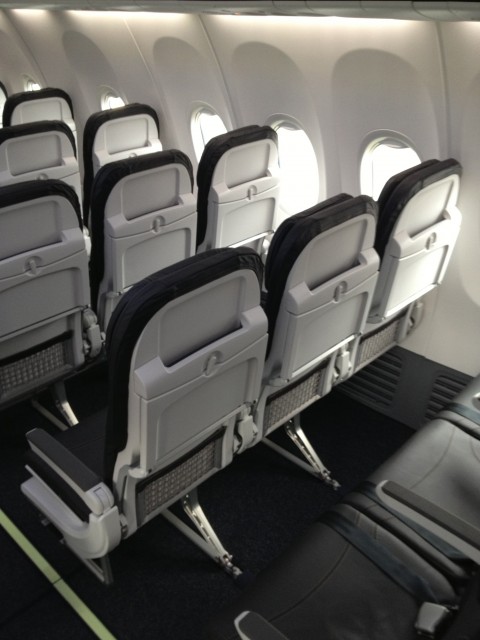
Here are the new Recaro seats on Alaska Airline’s Boeing 737-900ER. Image by Alaska.
The new Recaro seats still have those headrests that I have come to love on Alaska’s newer aircraft and they offer a pocket for magazines/safety card above the tray table and a net below. Something not as noticeable, but still very important, is the fact that seats are lighter. They are estimated to save 8,000 gallons of fuel per year per aircraft, which will really add up once all 38 are in operation.
“The Boeing 737-900ER is a great addition to Alaska Airlines’ all-Boeing fleet, providing industry-leading efficiency and passenger comfort,” said Brad McMullen, vice president of North America sales for Boeing Commercial Airplanes. “The airplane’s Boeing Sky Interior coupled with Alaska’s excellent customer service will provide passengers a flying experience no other single-aisle airplane can match. The 737-900ER also offers the best seat-mile cost on the market, which is especially important with today’s high fuel prices.”

The Boeing Sky Interior provides updated and larger overhead bins, as well as LED lighting. Image from Alaska Airlines.
Alaska’s new 737-900ERs will fly routes between the west and east coasts and is ETOPS certified to operate to the Hawaiian Islands. Alaska also recently announced 50 737 MAX aircraft in an effort to expand and modernize their fleet.
ADDITIONAL PHOTOS OF THE ALASKA AIRLINES 737-900ER by Brandon Farris.
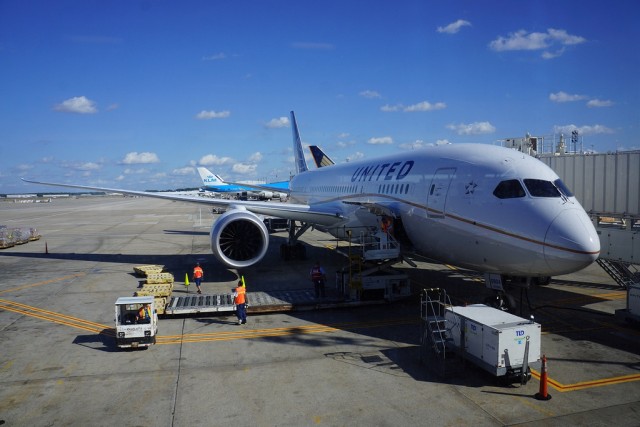
United Airline’s first Boeing 787 Dreamliner in Houston. Image by Chris Sloan / Airchive.com.
Chris Sloan, the man behind Airchive.com and is Executive Producer and Creator of Airport 24/7, was able to take the inaugural flight of United Airline’s first Boeing 787 Dreamliner. He agreed to share some of his photos and story with me and the rest of his story will be showing up on Airways Magazine in their February 2013 issues, hitting the shelves January 2nd. Here is his story, in his own words:
It is 5:00AM the morning of Sunday November 2, 2012 as I make my way over to Gate E5 at Houston’s George Bush Intercontinental Airport from a very quiet ticket counter, save for some journalists including Airways Magazine correspondent and director of social media, extraordinaire Jack Harty.
Despite the obscenely early hour, Jack and I are absolutely pumped with excitement and anticipation covering the story via live tweets, blogs, and for ’œAirways’. After foregoing a major development event, there is concern that this launch might be devoid of much of the pomp and circumstance of other launch flights, but this lack of showmanship, but this is doing little to dampen our enthusiasm for the inauguration of the first Boeing 787 to be operated by a U.S. carrier.
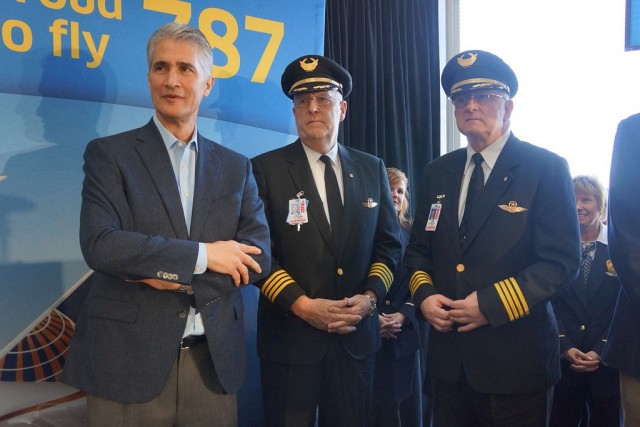
United’s CEO, Jeff Sismeck and flight crew stand on stage. Image by Chris Sloan / Airchive.com
On an optimistic note, Jeff Smisek, United’s President and CEO main theme is ’œThe 787 is worth the wait and all of our guests and members of the press are about to find out why’. Beyond all the usual groundbreaking features of the 787 normally mentioned: efficiency, pressurization, large windows, LED lighting, clean air, gust suppression technology, the humidified cabin, the ultra-quiet flight experience; Smisek gets some laughs when he says that ’œyou will all be very impressed with the lavatories’.
After the ribbon is cut, the boarding of the approximately 200 passengers begins promptly at 6:50AM. Flight 1116 from IAH-ORD is a normal operating flight with mostly paying passengers, some press, United high status customers, and of course a number of aviation enthusiasts. Many passengers are completely, but pleasantly surprised at the significance of this morning’s flight.
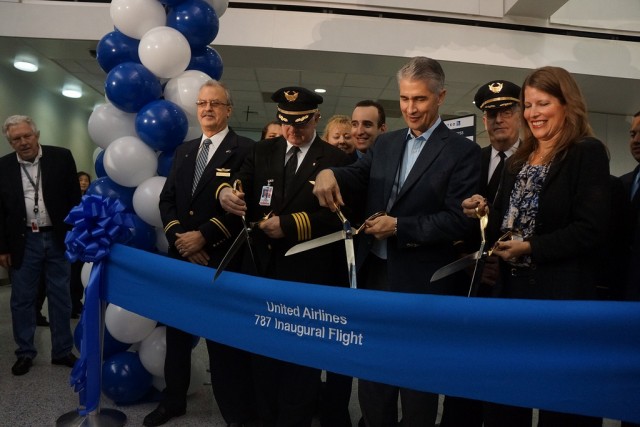
There have been many ribbons cut in the history of airline travel and this even was no different. Image by Chris Sloan / Airchive.com.
My first impressions of the cabin are positive. Though lacking the bar entry way of other airline’s 787, the entry through the gallery is still a major improvement over other aircraft, particularly with United’s blue LED boarding lighting program. I settled into my spacious seat, 6A in United BusinessFirst.
United initially chose to go big with a remarkable 8 flights scheduled on Day One involving 5 of United’s hubs: Houston Intercontinental, Newark, Chicago O’Hare, San Francisco, and Los Angles. These flights were to use 2 aircraft from the 787’s Houston base. United’s plan was to temporarily rotate the 787-8 through all of its domestic hubs that have a widebody service with domestic promotional and familiarization flights before it shifts to international operations on December 4th.
The journey to this day has been over 8 years in the making. United merger partner, Continental was the first airline in the America to placed an order for the Dreamliner shortly after the airliner was first offered to the market. Continental ordered 10 787-8s powered by the GEnx-1B.
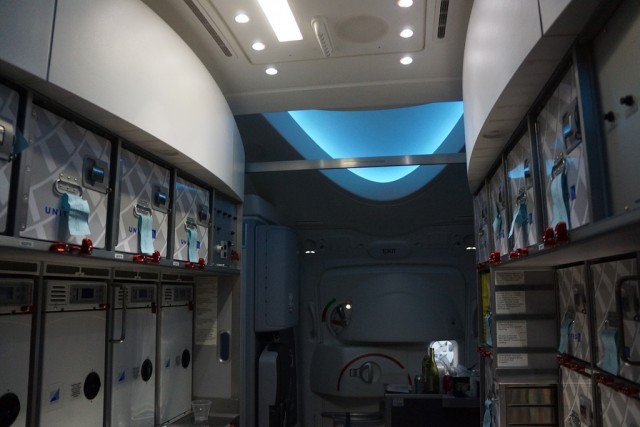
The entry way in United’s 787 is not as impressive as other 787’s, but nice none-the-less. Image by Chris Sloan / Airchive.com
The 787 would never fly under the Continental brand as United and Continental announced their merger in May 2010 and operationally on March 1, 2012. As everyone knows, the Continental Globe logo would carryover in the merger, replacing the tulip-a visual nod that this was in fact a merger of equals.
Ian Hankin, the Principal Engineer in Product Engineering points out in United PR releases that ’œgetting the 787 ready for regular operations has been more complex than for any plane to date, and the checklist of tasks runs many pages long. The different sections of the checklist correlate with various divisions throughout the company’. Hankin says ’œThis is due, in large part, to the advanced technology that makes up the plane’s structure (50 percent of which is composite materials) and the interior unique features.’

United’s BusinessFirst seats on the 787 Dreamliner. Image by Chris Sloan / Airchive.com.
United’s new BusinessFirst Cabin was initially to debut on the 787, but due to the delivery delays; it debuted on the 767 instead. It also does not feature the ’˜Dome’ dramatic entrance of some other airline’s 787s at door no. 2. Passengers enter through the galleys. Other than that, all the other Dreamliner features remain in place: the electronic dimmer buttons for the massive windows, high-arched ceiling, dynamic LED lighting, and enhanced ventilation and pressurization systems.
United’s 787 is configured with 36 seats in Business First 2-2-2 abreast with 60’ of pitch and 22’ in width. United has chosen a tighter seating layout then some 787 operators such as ANA and JAL opting for a 9 seats abreast in the economy cabins: 72 Economy Plus with 35-36’ of pitch and 18.3’ in width in a 3-3-3 abreast configuration, and 113 seats in Economy with 31’ pitch. On the return flight by the way, I sampled Premium Economy and was pleasantly surprised at how roomy it was. Panasonic’s eX2 provides the in-seat in-flight entertainment system on United’s 787 with Audio-Video on demand available at each seat. Power outlets are located at each seat in the business-class cabin and there are two for every three seats in the main cabin except for in the bulkhead rows where there are three outlets. Wi-Fi is not yet certified for the 787s. United is certainly not happy that their new flagship doesn’t have this capability, nor does any other 787 at this moment.
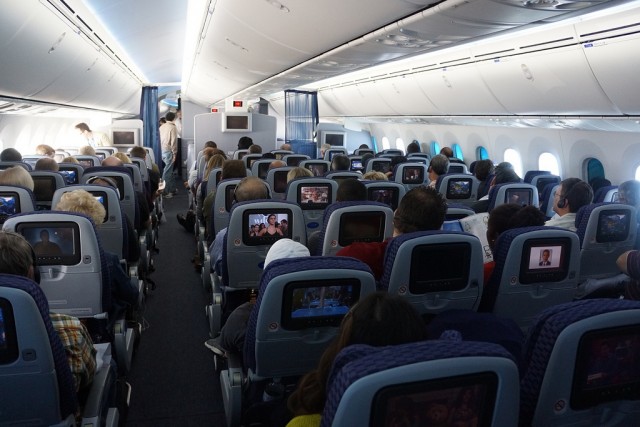
Economy is set up in a 3-3-3 format in United’s 787s. Image by Chris Sloan / Airchive.com.
According to the reservation agent, I was the first person to purchase a ticket on the first flight of Dreamliner service, the flight we are on today: United 1116. There was a lot of debate by #AvGeeks in the blogosphere and Twittersphere on whether this and the other November 4th flights would in fact be the first flights, or whether there would be special flights earlier. Even United’s press releases hinted at this possibility.
Unlike other airlines who chose splashy delivery ceremonies, United took delivery of their first 787 in a low-key manner on Sunday September 23rd. Rumors again swirled throughout the AvGeek world as to when the actual delivery would be and if there would be a large event. In the end, United chose to deliver their first 787 on Friday September 28, 011 from Boeing Field, instead of the usual Paine Field, as flight 7708 operating to Houston. There would be no fanfare upon departure. With 787 Fleet Standards Manager Captain Dave Lundy and Boeing 787 Assistant Fleet Manager Niels Olufsen at the controls, the journey between Seattle and Houston took approximately four hours departing at 9:56AM PST and landing at IAH at 3:56PM CST at an altitude of 41,000 feet. Upon arrival into United’s hub at stormy Houston George Bush Intercontinental Airport, the 787 was greeted by a water cannon salute before taxiing over to a hanger with excited employees waiting for it.
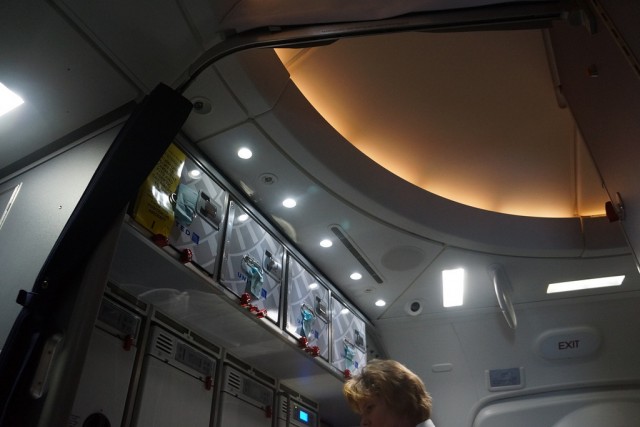
The LED lighting really sets the mood on the 787 Dreamliner. Image by Chris Sloan / Airchive.com.
This morning, Sunday November 4th there, are 4 flights operating the inaugural day: Our flight, 1116, is the first scheduled to depart early at 7:20AM with an arrival into Chicago O’Hare’s at 9:51AM. This plane is scheduled to turn-around and return back to Houston as flight 1510 after less than 2 hours on the ground in Chicago. Originally there were 8 flights scheduled, but now just 4. The remaining 2 flights of the day are: Houston-Los Angeles-Houston (IAH-LAX-IAH). United hubs at LAX, Newark, Cleveland, Denver, and Washington Dulles were scheduled to join the 787 Hub Tour throughout the month depending on the timing of the 2nd 787 being ready, with domestic revenue and familiarization flights continuing into early 2013.
We taxied out to IAH Runway 9, and at 7:27AM CST, began our very quick and very quiet 27-second take-off roll. With the aircraft only weighing 375,000 pounds (with 55,000 pounds of payload) out of a possible 502,000-pound max weight, Vr came at 140 knots in what was obviously a whisper-quiet take-off roll. A few seconds later we were airborne in a Northeastly direction to another round of applause, as is de rigueur in these occasions. We encountered a little chop in the climb to our FL41 cruising altitude, which gave a nice demonstration of the 787’s active aileron-driven gust suppression. The 787 is noticeably smoother than aircraft of its similar size such as the 767 and A330. Captain Starley came on the PA with some facts about the Dreamliner and today’s 2 hr, 9 min flight which would take us over to the east of Dallas, TX; Tulsa, OK; Springfield, MO; north of St. Louis, Joliet Illinois right into Chicago. We would fly at 504 knots and 580 mph. 19 minutes after take-off we leveled off at 41,000 feet.
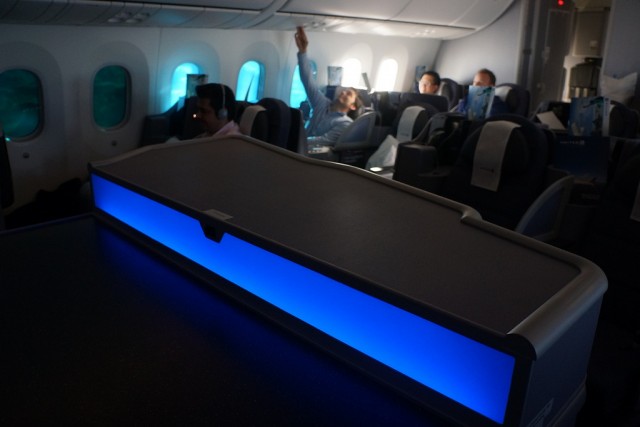
Lighting really provides a nice atmosphere in United’s 787 cabin. Image by Chris Sloan / Airchive.com.
At 7:54AM, United CEO Jeff Smisek came up from the back (yes, he was seated in Economy) and led a champagne toast, which was met with cheers. The seatbelt sign came-off briefly, albeit as the crew began their service. The LED lighting changed from the light blue cruising hue to a warm orange-ish tone, which supposedly accentuates the appearance of food. Apart from the commemorative Dreamliner souvenirs, first flight certificates, and cute custom 787 cookies, the service was fairly normal. In Business Class, we were offered tasty Egg McMuffins or cereal with fruit, yogurt, and croissants. In Economy, Buy-on-board meals were offered. The 8 Flight Attendants (11 FA’s are on international flights) who had specially bid this trip conducted a gracious, proud service while navigating around what had turned into an airborne party.
After a quick breakfast, I had an opportunity to checkout the comfortable new lie-flat seats that were very comfortable and a big improvement over the previous BusinessFirst product. If there is any complaint, it’s that the AC power and USB connections are located rather inconveniently behind the passenger at the back of the seat. The Panasonic eX2 in-flight-entertainment system is chock-a-block full of music and video on demand, games, and a high-resolution airshow moving map, but sadly United’s famous ’œChannel 9’ for listening to the pilot’s communications is missing. The IFE, while excellent, isn’t as cutting edge as some other’s but in United’s defense, it was state-of-the-art when initially ordered. My favorite, and previously unreported feature, was the smartly lit buffet / bar at the front of the forward BusinessFirst cabin. United’s seems somehow aesthetically better designed and more properly scaled than the ’œgalley bars’ on other 787s.
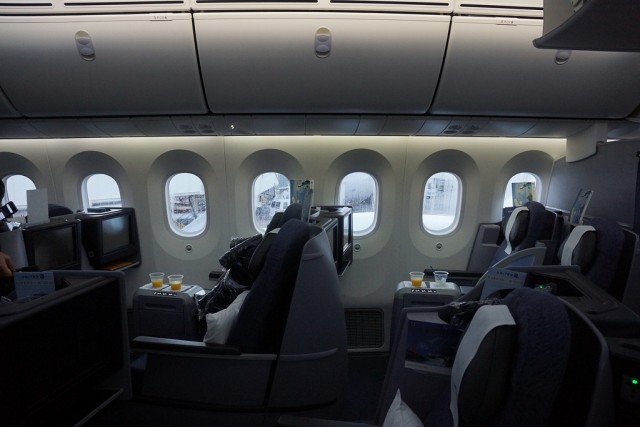
BusinessFirst seats in United’s Boeing 787 Dreamliner. Image by Chris Sloan / Airchive.com
With 40 minutes left in the flight, the air brakes came up and we began our initial descent. Captain Starley announced that we were burning an astoundingly low 9,000 pounds of fuel per hour, and that with 55 mph of tailwind were now flying at Mach .833. He termed the 787 as ’œa generational step forward’, yet ’œIt still flies like a Boeing and it’s a ’˜pilot’s airplane’’. Starley, who has flown commercially since 1973 and has flown everything from DC-8s to 777s, has the experience for his perspective to matter. Later to me, He offered that the 787s enhanced fuel efficiency is not only good for the environment and passengers, but it also equals job security for airline jobs as it allows airlines to fly more profitably at lower costs.
Captain Starley turned the 787 auto-pilot off at 4,000 feet and at 9:36AM CST executed a perfect ’œgrease job’ of a landing onto ORD’s runway 10, to cheers and clapping. We quickly exited the runway and as we taxied the first words heard over the PA, were ’œIt’s A Dream Come True’, and yes you guessed it: there was more applause. What’s an inaugural flight without the obligatory Grand Finale: ’œThe Water Cannon Salute’. These salutatory moments never get old as our 787 was given a bath from both sides of the jet. At United’s Gate C20, I deplaned right behind Jeff Smisek to a line of well-wishers and press. His remarks said it all: ’œAwesome! Just Awesome!’

United’s first two 787’s at IAH. Photo by Chris Sloan / Airchive.com.
After a short gate ceremony, United flight 1510 boarded for its on-time departure to Houston. This more subdued and conventional flight would be nearly devoid of all the ceremony of the inaugural flight. In fact, apart from being on the newest airliner of the 21st Century, it felt utterly normal. The Dream had become reality and that was the point.
See many more photos of Chris’ adventure on United’s 787 on his site Airchive.com.














